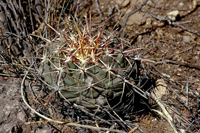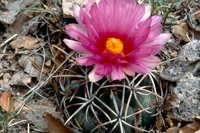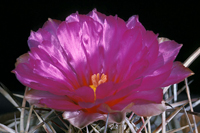Basionym: Echinocactus heterochromus F.A.C. Weber, Dict. Hort. Bois. 466 (1896).
Neotype: 3.5 km al Oeste de la Soledad, Durango, R.D. Worthington 10902 (TEX), E.F. Anderson, Bradleya 5: 68, (1987).
Synonyms: Thelocactus heterochromus (F.A.C. Weber) van Oosten, Kakteenkunde 58 (1940). Ferocactus heterochromus N.P. Taylor, Cact. Succ. J. Gr. Brit. 41: 90 (1979). Thelomastus heterochromus Frič, in Kreuzinger, Verzeichnis 10 (1935), nom. illeg. Echinocactus bicolor var. pottsii Salm-Dyck, Cact. Hort. Dyck. 173 (1850).
Description
Stem single, depressed to globose, 4-7 cm tall, 6-15 cm wide. Ribs 8, distinct. Tubercles rounded. Areoles without glands. Central spines 1-4, 20-50 mm long, ochre to reddish, straight, subulate. Radial spines 6-10, 16-40 mm long, ochre to reddish, straight, acicular to subulate. Flowers 45-80 mm wide, magenta with a red throat. Seeds 1.7 x 1.5 mm, testa cells convex with a verrucose surface sculpture.
Distribution
Mexico, Chihuahua and Durango, occurring in matorral xerofilo on limestone hills, at elevations of about 1300 to 2200 metres above sea level. Its range lies within the Northern and Central Chihuahuan subregions of the Chihuahuan Desert ecoregion.
Risk assessment
Thelocactus bicolor ssp. heterochromus is placed in the category A (threatened) of the Norma Oficial Mexicana NOM-059-SEMARNAT-2010.
Comments
This is the westernmost taxon in the genus. Usually, it has a depressed to globose stem with wider ribs. Spines are stouter, subulate, banded in red. The var. pottsii applies to those entities from Chihuahua that are intermediate between heterochromus and bicolor, but definitely belong to heterochromus for their lack of areolar glands.
Thelocactus bicolor ssp. heterochromus (Weber) Mosco & Zanovello, Bradleya 18: 62 (2000).
 The neotype of Echinocactus heterochromus F.A.C. Weber.
The neotype of Echinocactus heterochromus F.A.C. Weber.
3.5 km al Oeste de la Soledad, Durango, Mexico, R.D. Worthington 10902 (TEX 00372067).
Image courtesy University of Texas Herbarium.
enlarge
 Thelocactus bicolor ssp. heterochromus
Thelocactus bicolor ssp. heterochromus
Nazas, Durango
Photo: A. Mosco
enlarge
 Thelocactus bicolor ssp. heterochromus
Thelocactus bicolor ssp. heterochromus
Hidalgo del Parral, Chihuahua
Photo: A. Lausser
enlarge
 Thelocactus bicolor ssp. heterochromus
Thelocactus bicolor ssp. heterochromus
Photo: A. Mosco
enlarge